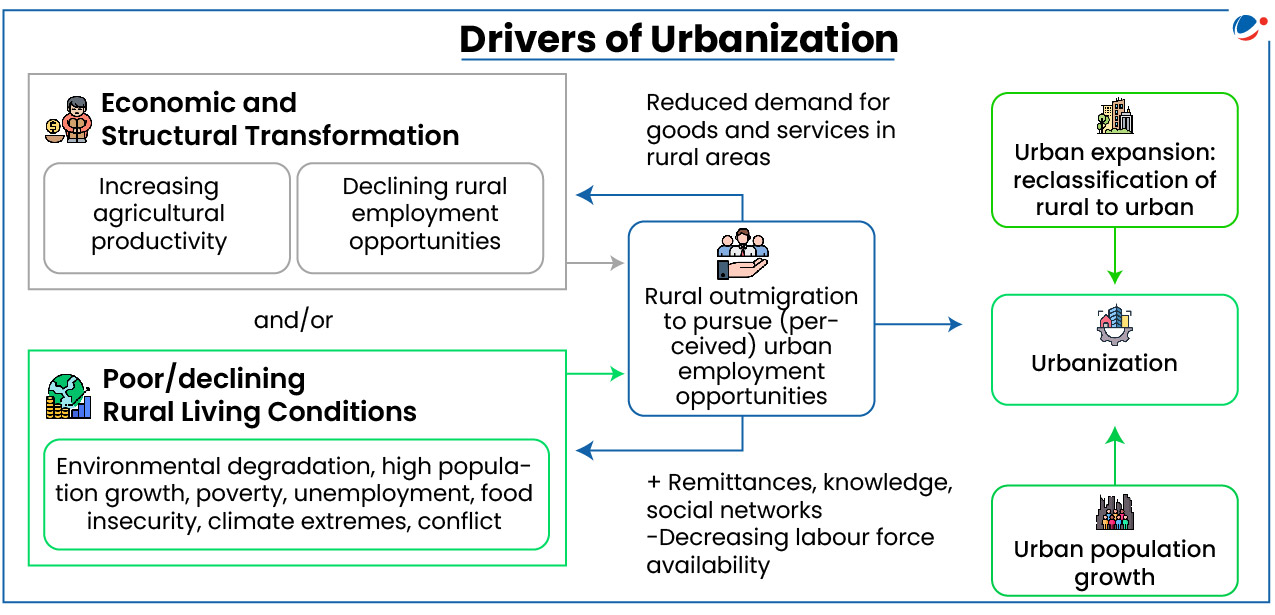Why in the News?
Budget 2025-26 announced the creation of Urban Challenge Fund (UCF).
What is the Urban Challenge Fund (UCF)?
- Urban Challenge Fund (UCF) of Rs 1 lakh crore aims to encourage states to think innovatively towards attaining sustainable urbanisation and redevelopment goals in existing cities.
- Fund is to implement the proposals for 'Cities as Growth Hubs', 'Creative Redevelopment of Cities' and 'Water & Sanitation'
- Financing Mechanism: Fund will finance up to 25% of the cost of bankable projects with a stipulation that at least 50% of the cost is funded from bonds, bank loans, and PPPs.
- An allocation of Rs. 10,000 crore is proposed for 2025-26.
What is the need for the UCF?
- Cater to rising Urban Population: India's urban population increased from 27.7% in 2001 to 31.1% (377.1 million) in 2011, at a rate of 2.76% per year. (Census 2011).
- Ensure Sustainability: Cities in India face the risk of looming water crisis, are prone to disasters like earthquakes, face severe pollution leading to urban heat island effect.
- E.g., Delhi is located in Seismic zone IV and is also one of the polluted cities in the world.
- Support Developmental Projects: Focus on integrated development covering critical infrastructure components in Transport and Logistics, Energy, Water and Sanitation, etc.
- Ensure absorption of the available funds: Ensuring ability to divert the available money properly into bankable, needs-based projects with effective delivery mechanisms.
- Address issues with Urban Planning: Land parcels of high urban densities are sub-optimally utilized due to fragmented and poorly recorded ownership of land.
- Urban Planning is a state subject as per the 12th Schedule of the Constitution.
- Address Deficit of Human Resources: It is a major bottleneck as the State machinery lacks qualified urban planners responsible for urban planning and design.
 Urbanisation in India
|
What more can be done to improve the situation of urban areas in India?
- Re-engineering and Strengthening of Urban Governance Structures: It can be done based on the 2nd Administrative Reform Commission (ARC) recommendations suggesting clear division of roles and responsibilities among various authorities.
- City Master Plan: It should be statutorily backed as it is essential for socio-economic development, better liveability, inclusion, citizen engagement, environmental sustainability, etc.
- About 52% of statutory towns in India lack any kind of master plan. (NITI Ayog, 2020)
- Town Planning Professionals: An All India Urban Planning Service similar to other civil services like Indian Information Service, etc., should be set up to have qualified planners. [High Level Committee (HLC) on Urban Planning under the Ministry of Housing and Urban Affairs (MoHUA)].
- NITI Ayog recommends constitution of National Council of Town and Country Planners as a statutory body.
- Integrated Capacity Building Programme: MoHUA is funding capacity-building events for town planners and urban functionaries which should be strengthened.
- Further, capacity building institutions should be rejuvenated by strengthening centres of excellence established by MoHUA.
- Reviewing existing legislations: States should undertake a regular review of planning legislations (including town and country planning or urban and regional development acts, etc.).
- Involvement of Citizens: Technocratic planning without adequate citizen participation is the reason for the disconnect between plan preparation and its acceptance on ground.
- Strengthen the role of Private Sector: This should be enhanced by creating gainful employment opportunities, adopting of fair processes for procuring technical consultancy services, etc.
Measures taken for reforming Urban AreasIndia
Global
|



